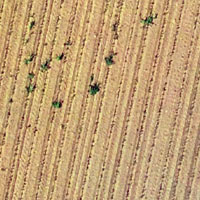Site- and time-specific early weed control is able to reduce herbicide use in maize - a case study

Accepted: 19 February 2021
HTML: 53
All claims expressed in this article are solely those of the authors and do not necessarily represent those of their affiliated organizations, or those of the publisher, the editors and the reviewers. Any product that may be evaluated in this article or claim that may be made by its manufacturer is not guaranteed or endorsed by the publisher.
Remote sensing using unmanned aerial vehicles (UAVs) for weed detection is a valuable asset in agriculture and is vastly used for site-specific weed control. Alongside site-specific methods, time-specific weed control is another critical aspect of precision weed control where, by using different models, it is possible to determine the time of weed species emergence. This study combined site-specific and time-specific weed control methods to explore their collective benefits for precision weed control. Using the AlertInf model, a weed emergence prediction model, the cumulative emergence of Sorghum halepense was calculated, following the selection of the best date for the UAV survey when the emergence was predicted to be at 96%. The survey was executed using a UAV with visible range sensors, resulting in an orthophoto with a resolution of 3 cm, allowing for good weed detection. The orthophoto was post-processed using two separate methods: an artificial neural network (ANN) and the visible atmospherically resistant index (VARI) to discriminate between the weeds, the crop, and the soil. Finally, a model was applied for the creation of prescription maps with different cell sizes (0.25 m2, 2 m2, and 3 m2) and with three different decision-making thresholds based on pixels identified as weeds (>1%, >5%, and >10%). Additionally, the potential savings in herbicide use were assessed using two herbicides (Equip and Titus Mais Extra) as examples. The results show that both classification methods have a high overall accuracy of 98.6% for ANN and 98.1% for VARI, with the ANN having much better results concerning user/producer accuracy and Cohen’s Kappa value (k=83.7 ANN and k=72 VARI). The reduction percentage of the area to be sprayed ranged from 65.29% to 93.35% using VARI and from 42.43% to 87.82% using ANN. The potential reduction in herbicide use was found to be dependent on the area. For the Equip herbicide, this reduction ranged from 1.32 L/ha to 0.28 L/ha for the ANN; with VARI the reduction in the amounts used ranged from 0.80 L/ha to 0.15 L/ha. Meanwhile, for Titus Mais Extra herbicide, the reduction ranged from 46.06 g/ha to 8.19 g/ha in amounts used with the ANN; with VARI the amount reduction ranged from 27.77 g/ha to 5.32 g/ha. These preliminary results indicate that combining site-specific and timespecific weed control might significantly reduce herbicide use with direct benefits for the environment and on-farm variable costs. Further field studies are needed for the validation of these results.
Highlights
- Efficacy of UAVs and emergence predictive models for weed control have been confirmed.
- Combination of time-specific and site-specific weed control provides optimal results.
- Use of timely prescription maps can substantially reduce herbicide use.
How to Cite

This work is licensed under a Creative Commons Attribution-NonCommercial 4.0 International License.
PAGEPress has chosen to apply the Creative Commons Attribution NonCommercial 4.0 International License (CC BY-NC 4.0) to all manuscripts to be published.

 https://doi.org/10.4081/ija.2021.1780
https://doi.org/10.4081/ija.2021.1780



